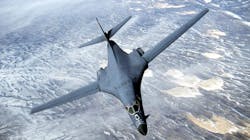Air Force makes plans to retire B-1B low-altitude jet bomber in favor of future B-21 Raider stealth plane
WASHINGTON – Earlier this year, the U.S. Air Force announced plans to retire the B-1B Lancer strategic jet bomber in favor of the future B-21 Raider stealth bomber. The National Interest reports. Continue reading original article
The Military & Aerospace Electronics take:
5 Dec. 2019 -- The B-1B will remain in service for some time, but unlike its older cousin the B-52, its days are apparently numbered. The B-1B has served in a variety of capacities since the 1980s, demonstrating a remarkable degree of mission flexibility.
The B-1B evolved from the B-1A, which itself rose from the ashes of the B-70 Valkyrie. U.S. strategic bomber development stalled out in the 1960s, as concerns about Soviet surface-to-air missile defenses forced the Air Force to reinvent its mission concept. Fast, high-flying bombers fell out of favor, while the B-52 (which excelled in a low-altitude role) remained relevant beyond its expiration date.
Nevertheless, the Air Force still wanted a supersonic jet bomber. The Nixon administration was more flexible on this question than the Johnson administration, and studies began in 1969. The first prototype flew in 1974. As designed, the B-1A could exceed Mach 2 at high altitude, Mach 1.2 at low altitude.
Related: Boeing moving forward with major avionics upgrade on Air Force B-1 bomber jet fleet
John Keller, chief editor
Military & Aerospace Electronics
